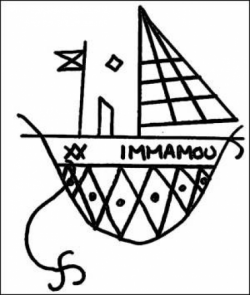What's the meaning of the Flaming chalice »
Flaming chalice
This page is about the meaning, origin and characteristic of the symbol, emblem, seal, sign, logo or flag: Flaming chalice.

A flaming chalice is the most widely used symbol of Unitarianism and Unitarian Universalism (UUism) and the official logo of the Unitarian Universalist Association (UUA) and other Unitarian and UU churches and societies.
The symbol had its origins in a logo designed by Austrian refugee Hans Deutsch for the Unitarian Service Committee (USC) (now the Unitarian Universalist Service Committee) during World War II. According to USC director Charles Joy, Deutsch took his inspiration from the chalices of oil burned on ancient Greek and Roman altars. It became an underground symbol in occupied Europe during World War II for assistance to help Unitarians, Jews, and other people escape Nazi persecution.
The chalice symbol is often shown surrounded by two linked rings (see illustration).
The two linked rings were used as an early symbol for the Unitarian Universalist Association, signifying the joining of Unitarianism and Universalism. In August 1962, the newsletter of the Midwestern Unitarian Universalist Association began using a chalice symbol drawn inside the two interlocking rings, as drawn by Betty King.
There is no orthodox interpretation of the flaming chalice symbol. In one interpretation, the chalice is a symbol of religious freedom from the impositions of doctrine by a hierarchy and open to participation by all; the flame is interpreted as a memorial to those throughout history who sacrificed their lives for the cause of religious liberty. In another interpretation, the flaming chalice resembles a cross, symbolic of the Christian roots of Unitarian Universalism.
Later, associations were made between this symbol and the Hussites religious sect. Czech reformer Jan Hus (1369–1415) began reading the Bible to his congregations in their native language, while the Catholic Church demanded that the Bible only be read in Latin. Also, during communion, the chalice was reserved for the clergy; the laity only received bread. When a church council condemned the practice of priests who were giving the chalice to their congregants, Hus refused to support the condemnation. After his execution by burning in 1415, followers of Hus adopted the "lay chalice" as an important symbol of their movement.
- 821 Views
Graphical characteristics:
Asymmetric, Closed shape, Monochrome, Contains both straight and curved lines, Has crossing lines.
Category: Religious Symbols.

More symbols in Religious Symbols:
Religious symbolism is the use of symbols, including archetypes, acts, artwork, events, or natural phenomena, by a religion. Religions view religious texts, rituals, and works of art as symbols of co… read more »
Citation
Use the citation below to add this symbol to your bibliography:
Style:MLAChicagoAPA
"Flaming chalice." Symbols.com. STANDS4 LLC, 2024. Web. 25 Apr. 2024. <https://www.symbols.com/symbol/flaming-chalice>.








Have a discussion about Flaming chalice with the community:
Report Comment
We're doing our best to make sure our content is useful, accurate and safe.
If by any chance you spot an inappropriate comment while navigating through our website please use this form to let us know, and we'll take care of it shortly.
Attachment
You need to be logged in to favorite.
Log In